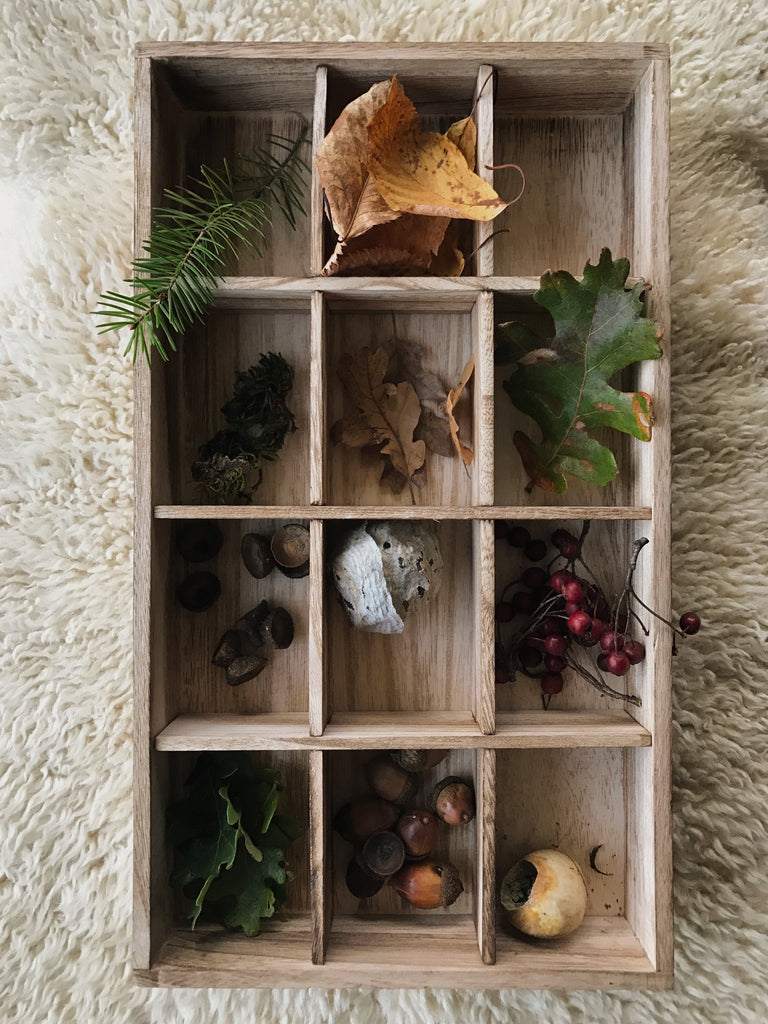Setting Up a Hands-On Nature Tray for Young Children

Setting Up a Hands-On Nature Tray for Young Children
On your next nature walk, learn how to set up a nature tray. Learn the benefits of outdoor learning and hands-on sensory activities with natural objects.
"In the meantime, relax. Take a break. Look at the clouds. Listen to the wind. Let the birds do the heavy lifting." ― Richard Louv
Most parents would agree that their children being able to explore the natural world around them is generally good. When they are outdoors, they are feeling the wind blowing, the grass beneath their feet, the earthy smells of fallen leaves, and the sounds of the critters going about their business. As a little one's caretaker, sharing these kinds of experiences is the stuff that makes lasting memories.
With that in mind, let's take a look and see how putting together a nature tray is a great way to bond with your child and nurture within them a love for the great outdoors.
What is a Nature Tray?
A nature tray is a hands-on sensory activity that gives young children a chance to explore the world around them with all of their senses. The basic idea of this DIY nature study is to take your child on a nature walk, gather a variety of natural objects, and then arrange them in a compartmentalized container, like a wood tray. At this point, you encourage them to experience the items' shapes, smells, colors, and textures. You may want a pair of safety scissors or an adult-run cutting tool if they have collected any plant materials that can be cut open for further examination and exploration.
Nature Walks and Outdoor Learning
We love leaving the classroom to go tromping around the woods with our children, exploring fields, and climbing trees. Along the way, children naturally gather things. Leaves are picked up, rocks and acorns find their way into pockets, and pinecones are carried in tiny hands. I can't recall a single nature walk I've ever taken with my kids where we didn't find at least one thing that must be taken home.
The advantage of having a classroom can come in eliminating distractions so that a student can focus on learning complicated arithmetic or memorizing the baffling spellings that have made their way into modern English. However, it's just as valuable to balance structured learning with a less-guided version of outdoor learning, where distraction is the main attraction!
Under normal circumstances, running ahead to pick a flower that caught their attention or collecting dead insects or animal casings might be discouraged. However, when a child has the freedom to truly explore, you never know what they can find. Oftentimes, they’ll even find something you never would have on your own. For example, I now know that it’s possible to find salamanders in my backyard!
It should be pointed out that materials for a DIY nature tray can be found in your yard, the park, the beach, the woods, or almost anywhere. However, if you truly don’t have easy access to somewhere natural (too cold and snowy to go outside, for example) there are plenty of ways to supplement your tray online through various teaching resources. While this can be a great way for anyone to get harder-to-find natural materials (not every yard will yield a snake’s shed skin), being outdoors and searching is still an important part of the experience for both you and your child.
A Scavenger Hunt and a Magnifying Glass
While collecting for a nature tray can be largely unstructured, your child may also benefit from guidance or a challenge. Arranging a nature activity like a scavenger hunt can be an excellent tool, especially if your tray is being prepared in a group setting. Specific goals can help guide the activity into nature and back to the home base, where all the gathered items can be sorted, compared, and examined.
When you reach this stage in the activity, it's often wise to have some form of magnification on hand. If your child or group is old enough (and the environment allows), a Jr. Microscope or even a hand-held microscope/light combination can show incredible details. However, if those items are unavailable or impractical given the age of the children, a simple magnifying glass can still offer a window into a different world.
Benefits of Sensory Trays
Whether you homeschool your kids, are looking for a new educational way to play with them on the weekends, or are looking for a gift idea for a grandchild, items to help them set up a nature table, sensory tray, or nature cutting tray can be a great option. Beyond the mindfulness of exploring their environment, the health benefits of running, walking, climbing, digging, fording streams, chasing dragonflies, and a million other discoveries are incalculable.
Outdoor learning, in general, has been shown to reduce stress, improve mood, boost concentration and increase a child's engagement. In addition, having the opportunity to interact in a hands-on way with their environment gives children the chance to work on many practical life skills, such as developing a sense of direction, being present, categorizing--the list goes on.
So get out there, bring your kids, and see what you can discover together!
